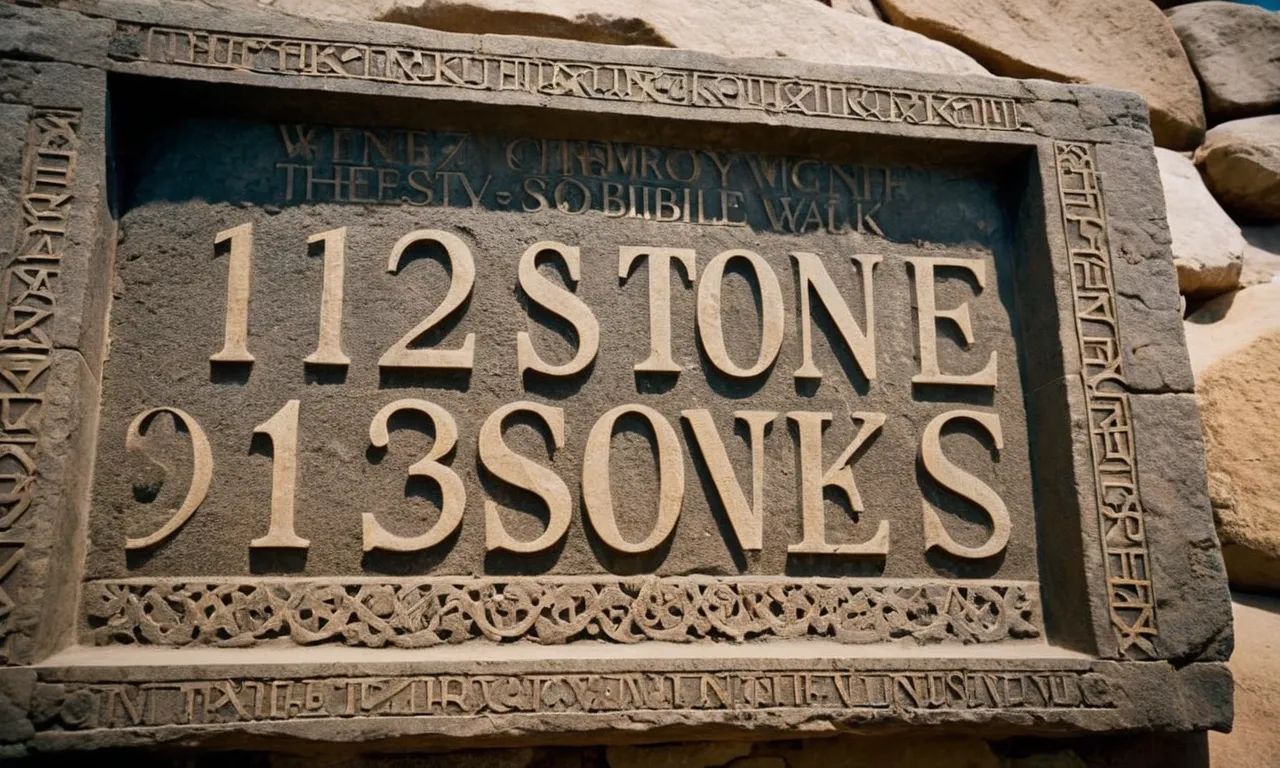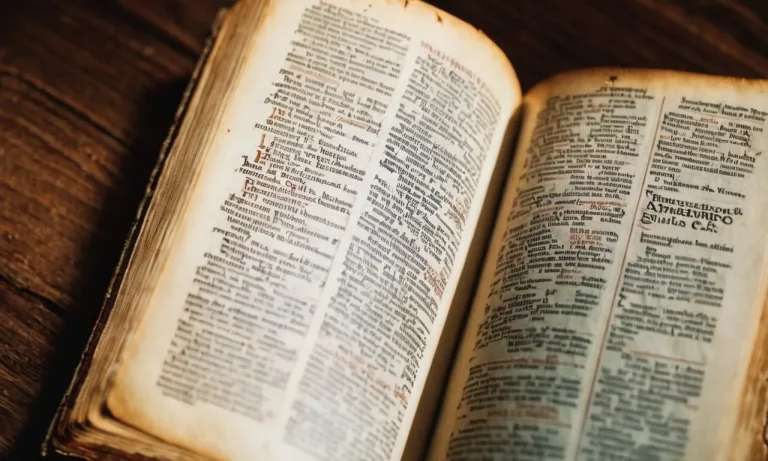What Are The 12 Stones In The Bible?
The 12 stones mentioned in the Bible carry great significance. These stones were used to represent the 12 tribes of Israel, commemorate miraculous crossings, and decorate priestly garments.
If you’re short on time, here’s a quick answer: The 12 stones in the Bible are types of gemstones that God instructed the Israelites to use for holy purposes including constructing the breastpiece worn by the high priest.
The Stones Representing the 12 Tribes of Israel
The 12 Gemstones on the Breastpiece Worn by Aaron
As described in Exodus 28, God commanded Moses to have the Israelites make sacred garments for Aaron, the high priest.
Part of these garments was an embroidered breastpiece with 12 precious and semi-precious stones, each inscribed with one of the names of the 12 tribes.
The 12 gems corresponded to the 12 sons of Israel, and some scholars believe the stones had a special meaning or significance related to the tribal name:
- Ruby (Reuben) – The firstborn son
- Topaz (Simeon)
- Carbuncle (Levi) – The priestly tribe
- Emerald (Judah) – The leader tribe from which kings came
- Sapphire (Issachar)
- Diamond (Zebulun)
- Jacinth (Dan) – Dan was located farthest north
- Agate (Gad)
- Amethyst (Asher)
- Beryl (Naphtali)
- Onyx (Joseph) – Joseph received the birthright from Reuben
- Jasper (Benjamin) – The youngest son
Wearing these 12 stones over his heart, Aaron could symbolically bear the names of the tribes before God whenever he entered the holy place.
The 12 Stones Taken from the Jordan River
After 40 years in the wilderness, God miraculously parted the Jordan River so the Israelites could cross over on dry land into the Promised Land. As described in Joshua 4, God instructed Joshua to have 12 men (one from each tribe) take a stone from the riverbed.
These 12 stones were set up as a memorial at Gilgal.
Scholars offer possible symbolic meanings for using stones from the Jordan River:
- A reminder of God’s power in parting the waters for them to cross
- Stones signifying God’s presence going before them into Canaan
- Memorial for future generations of God’s faithfulness
These piles of 12 stones represented the 12 tribes of Israel, commemorating this pivotal moment when God brought His people into the land He had promised.

The Significance of Precious Stones in the Bible
Symbolism of Colors and Gemstones
Gemstones have held symbolic meaning and spiritual significance for thousands of years. In the Bible, precious stones are used to symbolize beauty, wisdom, value, and God’s glory.
Specific colors and stones are chosen to represent aspects of God’s nature and authority.
For example, sapphire symbolizes divine favor, ruby symbolizes divine passion, emerald symbolizes healing and truth, and diamond symbolizes strength and invincibility.
Here are some key symbolic meanings in the Bible:
- Blue (sapphire, lapis lazuli) – Heaven, revelation, prophecy
- Purple (amethyst) – Royalty, priesthood, judgment
- Red/Scarlet (ruby, garnet) – Sacrifice, passion, blood of Christ
- White (diamond, pearl) – Purity, righteousness, resurrection
- Green (emerald, jasper) – Life, growth, abundance
Interestingly, the high priest’s breastplate contained 12 different gemstones, each symbolizing one of the tribes of Israel.
The brilliance of the stones reflected God’s glory and represented how He values and watches over His people.
Stones Chosen by God for Holy Tasks
Not only do gemstones hold symbolic meaning, but God specifically chose stones for sacred tasks and holy places.
For instance, onyx stones were used to construct the vestments for priests. The precious jewels on the breastplate lit up with divine light as God communicated with the priests.
Some key examples where God commanded certain stones to be used are:
- The two onyx stones on the shoulders of the priest’s ephod (Exodus 28:9-12)
- The 12 gemstones on the high priest’s breastplate symbolizing Israel’s tribes (Exodus 28:15-21)
- The sardius, topaz, diamond, beryl, and other gems adorning Lucifer before his fall from heaven (Ezekiel 28:13)
- The jasper and sapphire stones of God’s throne (Revelation 4:3)
- The 12 foundation stones of the New Jerusalem walls consisting of various gems (Revelation 21:19-20)
The 12 Foundation Stones in Revelation
The book of Revelation in the Bible describes a vision of the New Jerusalem, which contains 12 foundation stones engraved with the names of the 12 apostles.
These stones are believed to symbolize the apostles’ role in spreading the gospel and founding the Christian church.
Biblical Reference
The 12 foundation stones are mentioned in Revelation 21:14:
“The wall of the city had twelve foundation stones, and on them were the twelve names of the twelve apostles of the Lamb.”
This passage describes the New Jerusalem as having walls with 12 layered foundation stones. Each stone has one of the names of Jesus’s 12 disciples, underscoring their significance in God’s kingdom.
Meaning and Symbolism
Bible scholars offer several interpretations of the meaning and symbolism of these 12 stones:
- They represent the apostles’ leadership in founding the early Christian church through their teaching and ministry.
- The 12 stones honor the apostles’ faithfulness in spreading the gospel.
- The layered stones emphasize the apostles’ role as the underlying foundation of God’s kingdom on earth.
- The permanence and beauty of the precious stones signify how the apostles’ work has an enduring impact.
Though the passage does not specify the exact gemstone for each apostle, Bible historians have proposed possible correlations between the 12 stones and apostles, as shown in the table.
Appearance Tradition
The 12 foundation stones have been artistically depicted over history as glittering, jewel-encrusted stones.
For example, the New Jerusalem painting by Sister Grace Dateno shows the holy city with shining walls and 12 colored stones, representing this vision from Revelation.
This dazzling artistic tradition reflects the stones’ heavenly splendor described in Revelation 21:18-21. The passage notes the brilliance of the foundations, stating that “the twelve gates were twelve pearls, with each gate consisting of a single pearl.”
Conclusion
The 12 diverse stones mentioned in the Bible were carefully chosen by God to represent the 12 tribes and decorate holy vestments. Through studying these stones we see God’s attention to detail and the meaningful symbolism He intended.
Just as the 12 stones were precious in the eyes of God, so too are His people precious and valuable to Him.






